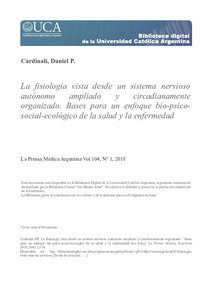Please use this identifier to cite or link to this item:
https://repositorio.uca.edu.ar/handle/123456789/1443| Título: | La fisiología vista desde un sistema nervioso autónomo ampliado y circadianamente organizado : bases para un enfoque bio-psicosocial-ecológico de la salud y la enfermedad | Autor: | Cardinali, Daniel Pedro | Palabras clave: | MEDICINA; FISIOLOGIA; SISTEMA NERVIOSO AUTONOMO; SUEÑO; SISTEMA LIMBICO; POSTURA; FUNCIONES MOTORAS; HOMEOSTASIS | Fecha de publicación: | 2018 | Editorial: | Ediciones Médicas del Sur | Cita: | Cardinali, D. P. La fisiología vista desde un sistema nervioso autónomo ampliado y circadianamente organizado : bases para un enfoque bio-psico-social-ecológico de la salud y la enfermedad [en línea]. La Prensa Médica Argentina. 2018, 104 (1). Disponible en: https://repositorio.uca.edu.ar/handle/123456789/1443 | Resumen: | Resumen: El sistema nervioso autónomo (SNA) es un componente fundamental del sistema nervioso cuya función es mantener la homeostasis y reaccionar de forma adaptativa a los cambios en el medio externo e interno. Participa en la regulación de la respiración, la circulación, la digestión, el metabolismo y el medio interno, la secreción exocrina y endocrina, las respuestas inmunes, la temperatura corporal y la reproducción. En este trabajo se analizará cómo la organización del SNA se construye en 4 niveles jerárquicos, a partir de un periodo de diferenciación crítico neonataL en el cual el medio ambiente y el vínculo afectivo con la madre juega un rol predominante. A continuación, se discutirá cómo la función del SNA cambia en las tres configuraciones corporales (vigilia, sueño de ondas lentas, sueño de movimientos oculares rápidos, REM) que se suceden durante un ciclo de 24 horas. Por último, se discutirá la aplicación de estos conceptos en la Unidad NeurofisioLOgía del Curso de Fisiología para alumnos de 20 año de la Facultad de Ciencias Médicas, UCA, enfatizando los aspectos instrumentales destinados a aumentar la participación de los alumnos en el proceso de enseñanza. Abstract: The autonomic nervous system (ANS) is a fundamental component of the nervous system whose function is to maintain homeostasis and react adaptively to changes in the external and internal environment. It participates in the regulation of resPiration, circulation, digestion, metabolism and internal environment, exocrine and endocrine secretion, immune response, body temperature and reproduction. In this review article I will analyze how the organization of the ANS is built on 4 hierarchicallevels, starting from a period of critical neonatal dijfirentiation in which the environment and the affictive bond with the mother plays a predominant role. Next, I will discuss how the ANS function changes in the three body corifigurations (wakefulness, slow wave sleep, fost eye movement, REM) that occur during a 24 hour cycle. Finally, the application of these concepts to teaching Neurophysiology at the Physiology Course for 2nd year medical students of the Faculty of Medical Sciences, Pontificia Universidad Católica Argentina, emphasizing the instrumental aspects intended to increase the participation of students in the teachingprocess is discussed . |
URI: | https://repositorio.uca.edu.ar/handle/123456789/1443 | ISSN: | 0032-745X | Disciplina: | MEDICINA | Derechos: | Acceso Abierto | Fuente: | La Prensa Médica Argentina. 2018, 104 (1) 0032-745X |
| Appears in Collections: | Artículos |
Files in This Item:
| File | Description | Size | Format | |
|---|---|---|---|---|
| fisiologia-vista-sistema-nervioso.pdf | 9,71 MB | Adobe PDF |  View/Open |
Page view(s)
2,783
checked on Apr 30, 2024
Download(s)
5,218
checked on Apr 30, 2024
Google ScholarTM
Check
This item is licensed under a Creative Commons License

